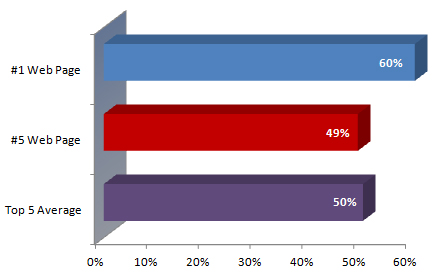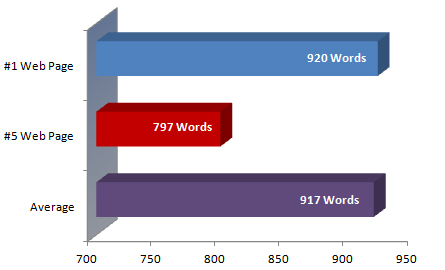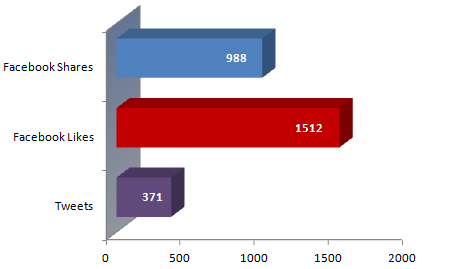
In this research the characteristics of web pages at the top of the Google search engine results pages (SERPs) were analyzed.
Recently I came across an interesting research study of Google's algorithm for SEO ranking conducted by Lisa Parmley at businessbolts.com The results were published on March 6th of 2013 and reflected here for our readers and followers: In this blog the word "we" refer to Lisa Parmley and her team.
Purpose
The point of the study was to analyze the characteristics of web pages at the top of the Google search engine results pages (SERPs).
What We Did
We randomly selected 100 keyphrases, typed them into Google and collected the URL’s of the first 5 results that showed up. The Firefox browser was used for all the searches. We were not logged into any Google products during the search phase.
The 100 keyphrases ranged from 2 word phrases up to 6 word phrases. The first 5 results in the Google search results listings were chosen, giving us a total of 500 different web pages to collect data from.
We ignored all the Google Adwords ads. We also skipped image listings, shopping site sets, and news site sets. We only analyzed actual web pages ranking #1 through #5 in the SERPs.
Here’s what we collected from each web page:
- Full URL
- Title tag
- Headline
- Number of subheadings
- Body copy word count
- Number of images in the body
- Number of videos in the body
- Number of referring domains to the web page (data from ahrefs.com)
- Social signals; Tweets, Facebook like, and Facebook shares (data from ahrefs.com)
We also analyzed the keyphrase the web page ranked high for in comparison with many of the factors listed above.
What We Found
There’s a lot of data, so let’s get to the results.
On-Site Factors
I’ll break each of the on-site factors down in this section along with the findings…
Title Tag
Out of the 500 web pages ranking in one of the top 5 positions in Google, 50% of them had the keyphrase in the title tag.
Title Tags & Keyphrases
To arrive at this percentage, a web page counted as a positive when it had the exact keyphrase in the title tag and when the keyphrase was included with slight variations. Here’s what is meant by a slight variation:
- If the keyphrase was singular and the title had a plural, (or the other way around) it was counted.
- If there was a word in between the keyphrase in the title, it was counted.
- When a word meaning the same thing was substituted, (guy vs. man) it was counted.
- If all the words of the keyphrase were in the title, but not in the exact same order, it was counted.
Since many of our keyphrases were randomly generated, they weren’t the type of phrases that would sound perfectly natural as a title tag or a headline. So we didn’t only limit it to times when the exact keyphrase was in the title.
Just to be complete, we also recorded the number of exact matches with the title tag as well. 23% of the high ranking web pages had the exact phrase in their title so it was still substantial.
Headline
Of the high ranking web pages, 43% of them used the keyphrase in the headline.
Headlines & Keyphrases
Again, we counted exact matches for the keyphrase or slight variations (see above).
20% of the web pages had the exact keyphrase within the headline.
Note that for both the title tag and the headline data, partial matches were not counted or these numbers would have been much higher.
As you can see, nearly half of the high ranking pages had the keyphrase (or a very close match) in the title tag and or headline (and many had it in both).
Subheadings
The average number of subheadings in the body copy was right around 6. Many high ranking pages did not have subheadings at all. Very few of the high ranking web pages included the exact keyphrase in the subheading (in fact, this number was well under a half of a percent). We did not count partial matches in the subheadings, only exact matches.
Word Count
Of the top ranking web pages, 916 was the average number of words in the body copy. The body copy included all the content excluding the header, sidebar, navigation menus, and footer area.
We measured the number of times the exact keyphrase was in the body copy. For this statistic, the we only counted the exact keyphrase (partial matches and slight variations were not included) On average, the exact keyphrase was found at a rate of slightly under half a percent.
Judging by the data we collected, you do not need to include odd or unnatural sounding keyphrases in your title tag, headline, subheadings or your body copy. If you’re going to include exact keyphrases, you really only need to include them one time. There’s no need to over-optimize your pages.
Images & Video
Of the 500 high ranking web pages, the average number of images per page was 7. Many high ranking pages had no images.
The average number of videos was well under 1 per page. In fact, most of the web pages had no videos on them.
Comparisons
We compared the #1 ranked webpage and the #5 ranked webpage for each keyphrase to see if there were any correlations for any of the major data. Here’s what we found:
Title Tags & Keyphrases Compared
On average, the #1 ranking web pages had the keyphrase (either the exact phrase or a slight variation of it) in the title tag 60% of the time. The #5 ranking web pages only had keyphrases in the title tag an average of 49% of the time. We did the same thing for headlines:
Headline & Keyphrases Compared
On average, the #1 ranking web pages had the keyphrase (either the exact phrase or a slight variation of it) in the headline 47% of the time. The #5 ranking web pages only had keyphrases in the headline an average of 41% of the time.
Based on our study, there’s a correlation between having the keyphrase in the title and/or the headline and the higher rankings (even just moving up page one of Google). Next we looked at the word counts between the #1 ranking web pages and those in the #5 spot:
Word Counts Compared
As you can see, the average ranking web page ranking in the #1 spot had a significantly higher word count than the average web page in the #5 spot by about 120 words.
We looked at number of images and videos and there wasn’t any real correlation there (at least in our study). It didn’t matter whether the web page ranked #1 or #5, the average number of images and videos still held up.
Off-Site Factors
The main off-site factors analyzed in the study were backlinks and social signals.
Backlinks
We collected the total number of referring domains for each of the 500 web pages we analyzed. If a referring domain linked back to the web page 300 times, it was still only counted as 1 link.
The number of referring domains to the high ranking web pages varied widely; from 0 to tens of thousands of referring domains for a single webpage. The average number of referring domains linking back to a high ranking web page in our study was 335.
That’s a significant number of links. Keep in mind these were just to specific web pages on a site, not the site as a whole. On average, the number of referring pages to the home page of these sites was significantly higher.
We looked at just how many of these high ranking web pages were internal pages and how many were the home page. Our data showed that 88% of the high ranking web pages were internal pages. Only 12% were home pages.
Home Pages vs. Internal Pages
In many cases, internal pages were ranking high even with zero backlinks to them. We checked further and in most of these instances, the home pages of these sites had a high number of backlinks. This wasn’t just limited to major sites like YouTube.com and Wikipedia.org. There were many examples of high ranking internal pages with very few backlinks on sites that were not major brand names. This indicates the overall popularity measured by backlinks can help you rank high for keyphrases without always having to gain backlinks to individual pages on your site.
Social Signals
There’s a lot of talk about social signals in SEO so we collected a few social signals and averaged those as well.
Average Number of Social Signals
The high ranking web pages analyzed in the study were tweeted 371 times, received 1512 Facebook likes, and had 988 Facebook shares. These are averages per web page. That’s a lot of social sharing!
Comparisons
Here we collected the backlink data of the sites ranking in position #1 and position #5 to see if there were any noticeable differences.
Backlink Comparison
It’s clear there’s a real correlation (at least with our data) between the number of referring domains/backlinks and how high up Google search results listings a site will go. Again, these are averages, but the web pages holding a #1 position had 662 backlinks. The web pages in the #5 position had an average of 142 backlinks.
So there’s a big difference when it comes to backlinks by nearly a factor of 5. It shows how much backlinks play a role in rankings.
And interestingly, the same goes for social signals.
Social Signal Comparison
The #1 ranking web page had many more social signals than the web page in the #5 position. The web pages in the top spot had more than twice as many Tweets, over 10 times as many Facebook likes, and twice as many Facebook shares.
It’s unclear if Google looks at social signals for their ranking, but even if they don’t, high levels of social signals are a good indicator that a page is popular and may rank high.
Take Aways
The study isn’t perfect, but it does give us some characteristics of high ranking web pages on Google at the present time.
Here are a few of the characteristics of high ranking web pages according to our research:
On-Site Optimization
- There was a substantial amount of text on the web pages. According to the study, a good number to target is around 900 words, but keep in mind this is only an average, there was a wide variety. So there were high ranking pages with far less content and those with quite a bit more.
- Many of the pages use the exact keyphrase or a slight variation of the keyphrase within the title tag and/or the headline. At the very least nearly all of the high ranking pages included individual keywords in the title and headline.
- The pages we analyzed used keyphrases sparingly in the body copy of the content (under a half a percent keyphrase density was the average).
- On average the high ranking web pages included 6 subheadings. These subheadings included individual keywords where they made sense.
- Using an exact keyphrase one time within the body copy (including the subheadings) is plenty. Many of the pages also had individual keywords incorporated throughout the copy where they made sense.
- Although the study shows it’s definitely possible to gain a high ranking without images or video, many of the sites we analyzed incorporated images into the content and to a lesser degree, video.
The biggest take away from the on-site optimization portion of the study is to write naturally (over-optimization should be avoided), but do not waste the opportunity to help label what your content is about for the search engines and your visitors.
Off-Site Optimization
- Internal web pages are more likely to rank high than home pages. Home pages are often optimized for a general keyphrase (which can be harder to rank high for) while internal pages can do the heavy lifting for specific keyphrases.
- There’s a big difference between the number of backlinks required to go from #5 on page one of Google to the #1 spot. The #1 ranking web pages had an average of nearly 5 times as many links as those in the #5 spot.
- Social signals may play a role in your rankings (or at least be a good indicator in the type of content that ranks high).
The biggest take away with off-site optimization is to gain as many links as possible to your web pages. Because of this, it’s going to be in your best interest to build one site and focus your energy on that instead of building a number of sites.
So those are the conclusions of the study, backed by actual data. If you found value in this study please share it as a lot of time went into putting it together for you.
Let us know if any of the findings were surprising to you by adding to the comments below.





















Leave a Comment
comments powered by Disqus